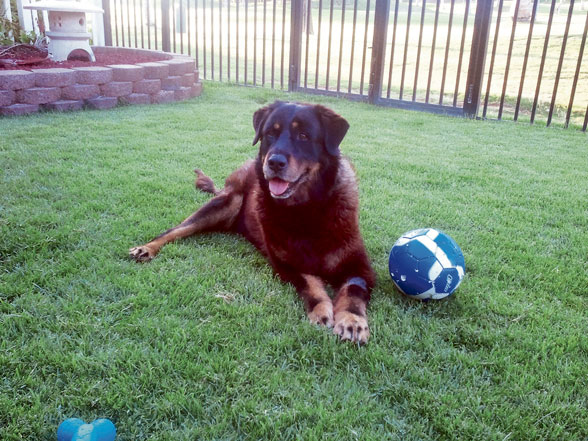Stem-cell Surgery Loosens Up Dog’s Arthritic Limbs
By CAITLIN BASILIO
Honolulu’s first in-clinic stem cell therapy was performed June 21 on Kumba, a 13-year old Rottweiler/Labrador mix, at Surf Paws Animal Hospital in Hawaii Kai Towne Center.
Kumba suffered from severe arthritis that limited his mobility, but he’s now able to act like himself and move around again.
“It was so sad to see him lying down every opportunity he had because of the pain,” said Surf Paws’ owner, Rumi Hospodar. “Now he actually gets up and barks every time he hears the mynah birds squawking outside!”
eo_stem
The procedure involved removing fat tissue from the dog, separating the stem cells from the fat, activating and then injecting the cells into the affected area. The technology used Kumba’s own stem cells to heal himself.
The drug-free treatment was developed by Kentucky-based Medivet America for dogs, cats, horses and other animals suffering from osteoarthritis, hip dysplasia, ligament and cartilage injuries and other degenerative diseases. Performed entirely in-clinic, the therapy saves time and money, costing about $1,800 for dogs and cats.
Today, more than two months later, Kumba is recovering well, according to Hospodar. “He is doing much better than before, gets up more gracefully with less effort and begs at the table during dinner. He’s also back to doing his ‘gallop’ when he’s excited, and it’s so good to see him enjoying life again.”
“The therapeutic window for stem cells is about 20 to 60 days in dogs, so we still expect to see more improvement as the stem cells do more of their regeneration work,” added Carole Spangler Vaughn, Ph.D. with MediVet Hawaii. She noted that stem cells, which can become any cell in the body, regenerate cartilage in arthritic patients, reducing pain and increasing mobility.
After the procedure, dogs are supposed to slowly ease back into their daily life. “They feel so good suddenly after a long time of suppressed movement,” Hospodar said. “They want to run around and jump and play, but since their muscles have atrophied after the limited movement, they’re not immediately ready for that type of movement.
“This was such an easy and non-invasive procedure, I just wish we had done it sooner.”






